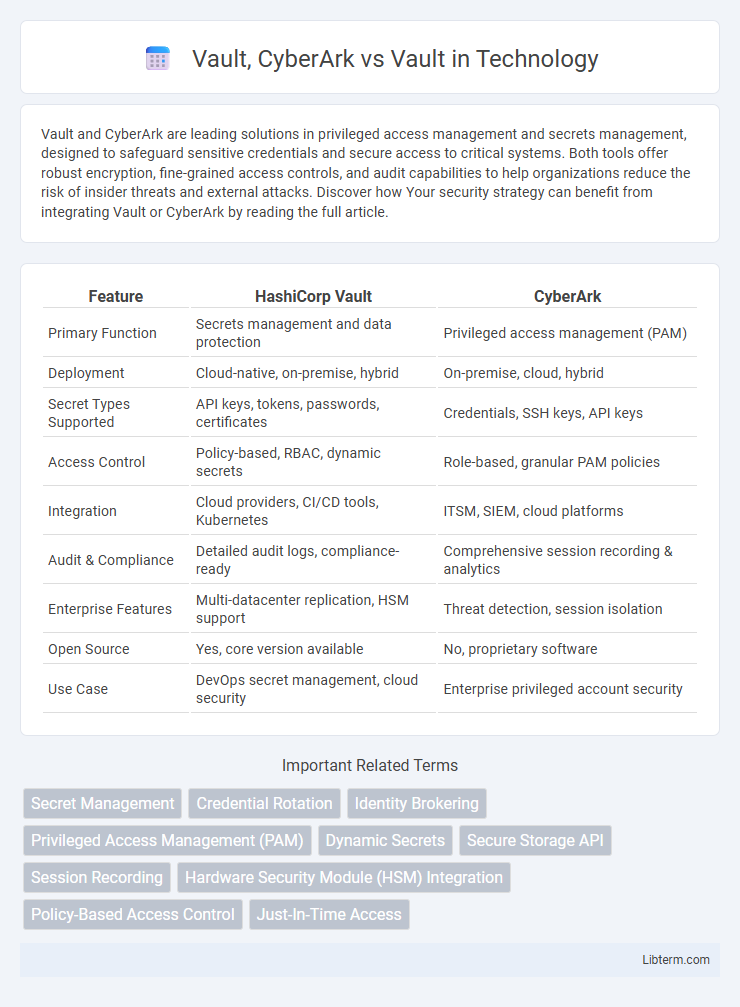Vault and CyberArk are leading solutions in privileged access management and secrets management, designed to safeguard sensitive credentials and secure access to critical systems. Both tools offer robust encryption, fine-grained access controls, and audit capabilities to help organizations reduce the risk of insider threats and external attacks. Discover how Your security strategy can benefit from integrating Vault or CyberArk by reading the full article.
Table of Comparison
| Feature | HashiCorp Vault | CyberArk |
|---|---|---|
| Primary Function | Secrets management and data protection | Privileged access management (PAM) |
| Deployment | Cloud-native, on-premise, hybrid | On-premise, cloud, hybrid |
| Secret Types Supported | API keys, tokens, passwords, certificates | Credentials, SSH keys, API keys |
| Access Control | Policy-based, RBAC, dynamic secrets | Role-based, granular PAM policies |
| Integration | Cloud providers, CI/CD tools, Kubernetes | ITSM, SIEM, cloud platforms |
| Audit & Compliance | Detailed audit logs, compliance-ready | Comprehensive session recording & analytics |
| Enterprise Features | Multi-datacenter replication, HSM support | Threat detection, session isolation |
| Open Source | Yes, core version available | No, proprietary software |
| Use Case | DevOps secret management, cloud security | Enterprise privileged account security |
Introduction to Secrets Management
Vault and CyberArk are leading solutions in secrets management, designed to securely store, manage, and control access to sensitive information such as API keys, passwords, and certificates. Vault, developed by HashiCorp, offers dynamic secrets, leasing, and revocation features with a strong emphasis on cloud-native environments and integration with DevOps workflows. CyberArk focuses on privileged access management with robust secrets vaulting capabilities, tailored for enterprise environments requiring stringent access controls and detailed audit trails.
Overview of Vault
Vault by HashiCorp is an open-source tool designed for securely managing secrets, encryption keys, and access to sensitive data across cloud and on-premises environments. It provides features such as dynamic secrets, data encryption, leasing and renewal mechanisms, and detailed audit logging to ensure robust security and compliance. Vault enables centralized secret storage with fine-grained access control, making it a preferred choice for organizations aiming to protect sensitive information in complex infrastructures.
Overview of CyberArk
CyberArk is a leading privileged access management (PAM) solution designed to secure, monitor, and manage privileged accounts across enterprise environments. It offers robust features such as password vaulting, session isolation, threat analytics, and compliance reporting, which provide comprehensive protection against insider threats and cyberattacks targeting privileged credentials. CyberArk's architecture supports cloud, hybrid, and on-premises deployments, making it a versatile choice for organizations seeking advanced security controls over critical access points.
Key Features of Vault
Vault by HashiCorp excels in secrets management, offering dynamic secrets, encryption as a service, and robust access control policies. CyberArk, while strong in privileged access management and session monitoring, lacks Vault's extensive API-driven automation and multi-cloud support. Vault's modular architecture supports various authentication methods and integrates seamlessly with DevOps tools for scalable security workflows.
Key Features of CyberArk
CyberArk excels in privileged access management with features like secure credential vaulting, session monitoring, and threat analytics, ensuring robust protection for high-risk accounts. Unlike HashiCorp Vault, which emphasizes secrets management and encryption as a service, CyberArk provides comprehensive risk mitigation through governance and compliance reporting. Its advanced integration capabilities with SIEM systems and real-time threat detection tools set it apart in enterprise cybersecurity environments.
CyberArk vs Vault: Architecture Comparison
CyberArk employs a centralized architecture designed for privileged access management, featuring components like the Digital Vault, Central Policy Manager, and Privileged Session Manager, enhancing security with encrypted storage and session monitoring. Vault by HashiCorp uses a distributed, seal/unseal mechanism with a focus on secrets management and encryption as a service, leveraging dynamic secrets, token-based authentication, and a pluggable storage backend for flexibility. The key architectural distinction lies in CyberArk's emphasis on comprehensive privileged account security, while Vault prioritizes scalable, modular secret storage and access control.
Security and Compliance Considerations
Vault by HashiCorp and CyberArk both offer robust secret management solutions with distinct security and compliance strengths. Vault emphasizes cryptographic key management, dynamic secrets, and detailed access policies aligned with SOC 2, HIPAA, and GDPR standards, ensuring secure storage and automated secret rotation. CyberArk excels in privileged access management (PAM) with comprehensive session monitoring, threat analytics, and compliance frameworks including PCI-DSS and NIST, making it ideal for enterprises requiring stringent control over privileged credentials.
Use Cases: Vault vs CyberArk
Vault excels in dynamic secrets management, encryption as a service, and identity-based access controls for cloud-native environments, making it ideal for DevOps and microservices architectures. CyberArk focuses on privileged access management, secure credential storage, session monitoring, and compliance auditing, serving enterprises with critical infrastructure and regulatory requirements. Use cases for Vault emphasize automation and developer workflows, whereas CyberArk targets securing high-risk privileged accounts and insider threat mitigation.
Integration and Ecosystem Support
CyberArk offers extensive integration capabilities with over 200 applications, cloud platforms, and DevOps tools, making it ideal for enterprises seeking comprehensive ecosystem support and seamless credential management across diverse environments. Vault by HashiCorp emphasizes flexible and programmable secrets management through an open API, allowing custom integrations but requiring more configuration effort to connect with third-party systems. While CyberArk excels in out-of-the-box integrations and centralized access control, Vault provides a more modular and developer-friendly approach to fit complex, cloud-native infrastructure pipelines.
Choosing the Right Solution for Your Organization
CyberArk offers comprehensive privileged access management with advanced threat analytics and secure credential storage, ideal for enterprises requiring robust identity security and regulatory compliance. HashiCorp Vault excels in secrets management and dynamic infrastructure credentials, providing flexible open-source integration and automation for DevOps environments. Evaluating your organization's priorities for scalability, cloud-native support, and compliance requirements will guide the decision between CyberArk's enterprise-grade PAM and Vault's developer-friendly secrets management capabilities.
Vault, CyberArk Infographic

 libterm.com
libterm.com